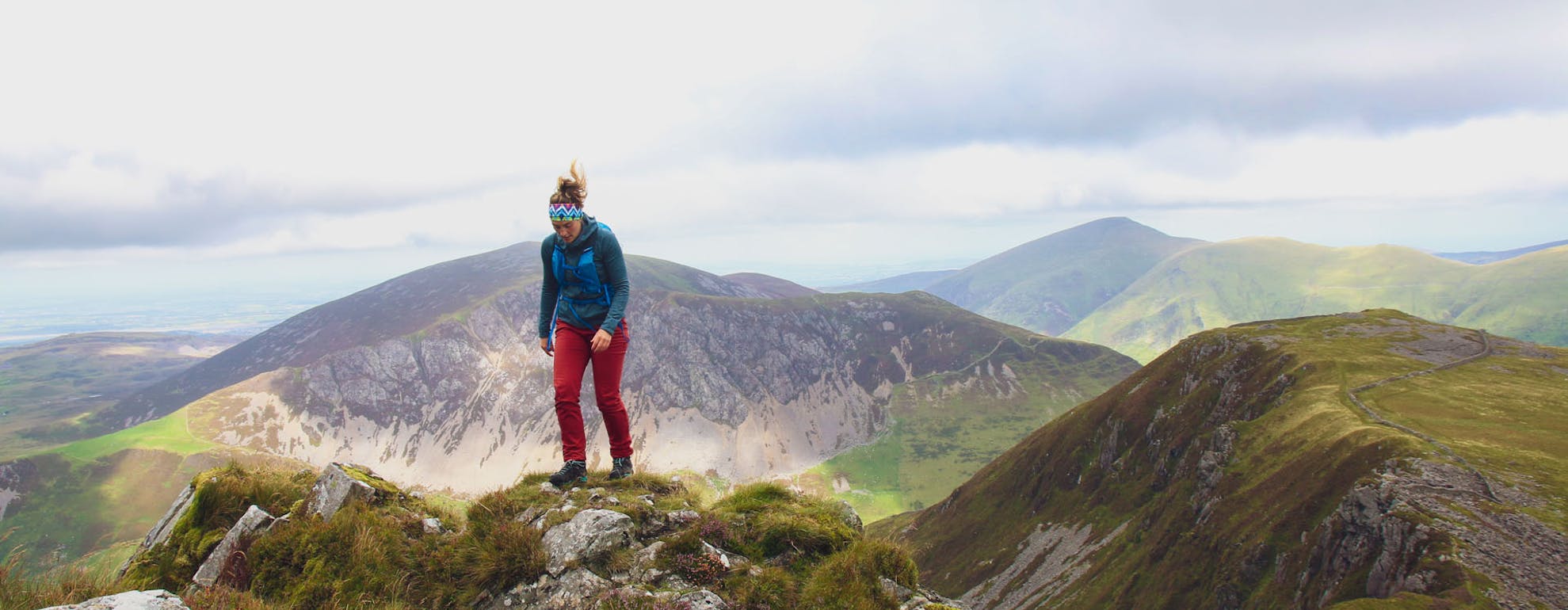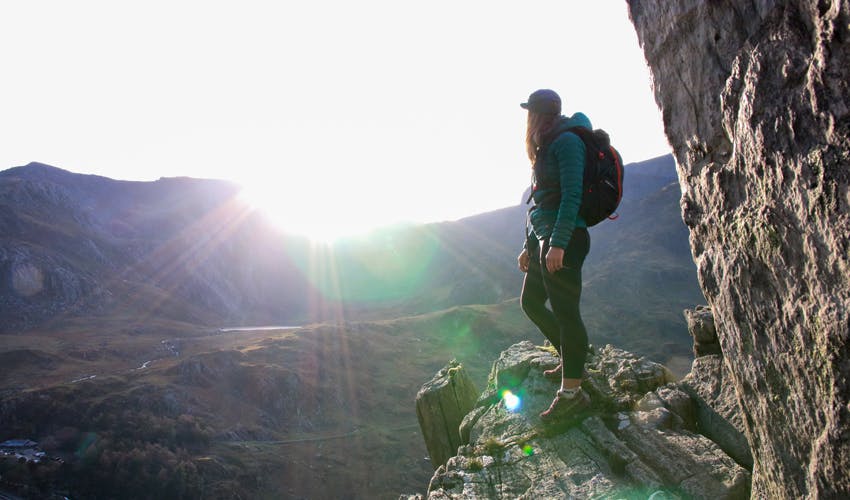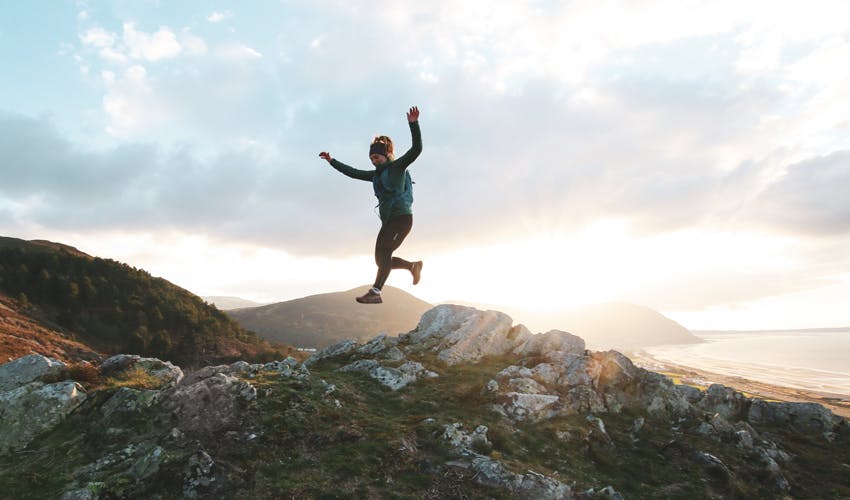
Health & Wellbeing
A Beginner's Guide to Hiking with Montane ambassador Kathryn Roberts
Kathryn Roberts is a Montane ambassador and freelance Outdoor Instructor based in North Wales. She offers a wide range of courses and events from beginner navigation courses through to advanced mountaineering and overseas expeditions. When she's not working outdoors you will find her running in the mountains or climbing on the sea cliffs or mountain crags of Snowdonia.
ㅤ
ㅤ
1. HOW DO I PLAN A HIKE?
To plan a hike you first need to know where you plan on walking so you can find the information relevant to the location you plan to visit. UK Hillwalking is a great website full of loads of useful information and articles specific to the hillwalker. They also have route cards which are a great tool for planning your walk. We're big fans of printed media and love nothing more than flicking through a Cicerone guidebook or Trail Magazine looking for inspiration and new places to explore. Often if we find a route in a magazine we will cut it out, laminate and keep it for later or share it with friends.
ㅤ
2. DO I NEED ANY OUTDOOR EXPERIENCE TO GO HIKING?
Simple answer, No. It's all about picking your battles and making sure you're equipped and prepared for what you hope to take on. If you have little or no previous experience, choose a popular walk that has lots of escape options or houses nearby. If you don't have any navigation experience it's probably not ideal to head into remote mountainous terrain, so instead choose lower level walks with lots of easier paths and more escape options. Once you gain some experience and start to develop your navigation and experience then you can start heading into more remote terrain.
ㅤ
3. WHAT THINGS DO I NEED TO CONSIDER BEFORE SETTING OFF?
Your number one safety consideration should be the weather. How will the conditions impact your day? If you only have a budget waterproof and it's forecast to be cold or wet, then you probably won't have an enjoyable time. Are the wind speeds dangerous? Wind speeds below 30mph are generally fine, but a 40 mph+ will present significant risks (e.g. Hypothermia, injury) which could make for a bad day. Check the weather and plan accordingly.
ㅤ
4. WHAT KIND OF KIT DO I NEED TO WEAR FOR HIKING?
The three-layer system works well and is a great place to start if you're new to hillwalking. As you get more experience in the outdoors you can tweak this system and dial it in so it works for you.
ㅤ
1. BASE LAYER
The Baselayer is moisture management and allows moisture to move away from the skin and wick through the layers. Modern synthetic fibres are no longer as sticky as they used to be and base layers like the Montane Dart t-shirt are treated with polygiene which also reduces odour that's common with other budget baselayers. Natural fibres like Merino offer superior moisture management and remain warm when wet. I personally love the Montane Premino 140 as it's a Merino Polyester mix and offers warmth, excellent moisture management and doesn't smell after several days out in the hills. If you find you overheat and sweat a lot during a hike consider taking a spare base layer to swap during the day.
WE RECOMMEND: Montane Primino Baselayers
ㅤ
2. MID LAYER
The main job of a mid-layer is to be a breathable insulating layer that allows you to manage your temperature and wick moisture away. A budget mid-layer would be a fleece, which is relatively inexpensive and offers a good level of warmth for the cost. As the price increases, more advanced materials become available, like Primaloft insulation and down, offering superior warmth in a small pack size. Personally, I like to use synthetic insulation like Primaloft as it stays warm when wet, which is common in the mountains of the UK. Contemporary down jackets have hydrophobic down but are far less efficient in very wet conditions
WE RECOMMEND: Montane Allez Micro-Fleece Hoodie
ㅤ
3. OUTER LAYER
The outer layer is the most important as it protects you from the wind, rain and snow. If you're buying your first outer layer I would certainly recommend a waterproof layer and make sure it's going to meet the demands of your ambitions or plans. A budget waterproof is fine for low level walks where you can get into a pub or café if you get too wet. If you're in the mountains you won't have that luxury so making sure your waterproof can sustain heavy rain for long periods is essential to avoiding a very unpleasant day out in the hills.
WE RECOMMEND: Montane Pac Plus GORE-TEX Waterproof Jackets and Montane Waterproof Pants
ㅤ
4. BOOTS
Everyone's feet vary in size and shape and we all have a different expectation of what is comfortable and what we want to get out of our boots. When it comes to finding the perfect boot we recommend doing some research and seeking expert advice to find a pair to suit your individual needs.
Check out our Hiking Hub for the latest walking shoe/boot reviews and recommendations, plus other kit and hiking related articles.
ㅤ
5. SPARE KIT
I will always pack a spare pair of socks into my pack. There is nothing more uncomfortable than your feet moving around due to the moisture in your socks.
ㅤ

ㅤ
5. WHAT SHOULD I EAT?
The best way to fuel your body during long days is to eat nutritional wholesome foods. Sandwiches, snack bars, fruit and nuts are great food for the mountains and ensure you keep a good level of slow-burning carbs that will keep you going all day. Avoid large amounts of sugary food and drinks as your body burns them quickly which will leave you on a physical and emotional rollercoaster throughout the day. Carrying nuts or dried fruit in your pocket can be a great way of snacking and keeping your energy levels up while on the move. Always remember to carry enough fluids in your bag to last the day.
Check out the SportsShoes article 8 Best Hiking Snacks to Stay Fuelled for more ideas.
ㅤ
6. DO I NEED TO CARRY A FIRST AID KIT? IF SO, WHAT DO I NEED?
A first aid kit is only as good as the person using it. Make sure you have a first aid kit that you know how to use and one that is functional. Common first aid needs are things like blisters, scrapes, cuts, sprains and the usual headaches or joint pains. Carrying a bandage, plasters, scissors and some tape will equip you to deal with basic first aid issues. Antihistamines are important for allergic reactions (Stings, pollen) and carrying an energy gel is incredibly useful for people with low blood sugar (Diabetics), or those who have run out of energy. In all my years of working in the mountains, a simple energy gel has become the most used item in my first aid kit.
If you're spending large amounts of time in the mountains, we would also recommend undertaking a first aid course. All the emergencies I've (Matt) been involved with have been from people not in my group. The situations have ranged from people suffering severe heat stroke to allergic reactions and panic attacks. The regular first aid courses I've undertaken ensured I could manage these people until help arrived. Something worth considering if you intend on spending lots of time outdoors.
ㅤ
7. HOW DO I NAVIGATE?
Being able to navigate is an important part of enjoying the outdoors and a pretty essential skill if you want to make sure your day goes as planned. Maps are still an important part of navigating and are a far more reliable tool than just relying on technology. You can find some useful navigation tips on the Ordnance Survey website or take a course by a qualified outdoor instructor. Apps are also a great tool for navigation but given that technology can sometimes be unreliable and batteries run out, we would always recommend a mixture of both map and apps to make sure you keep some battery life in your phone just in case.
WE RECOMMEND: Outdoor Active - Subscription mapping service. OS Locate – Free app and gives a grid reference for use in emergencies.
Check out our Beginner's Guide to Hiking and Trail Running Navigation
ㅤ

ㅤ
8. OUR TOP TIPS FOR HILL WALKING AND HIKING
1. TAKE A PHONE FOR EMERGENCIES
Using your phone for navigation and as a camera is guaranteed to wipe out your battery and leave you with little power to call for help if it all goes wrong. If you're walking in a group make sure one person keeps their phone just for emergency calls and make sure it's kept in a waterproof case.
ㅤ
2. WEAR A GOOD PAIR OF WALKING BOOTS
Common reasons for Mountain Rescue call-outs are trips, slips and falls. Making sure you have a good pair of walking boots or mountain-specific shoes will ensure you have adequate grip and reduce your chances of falling or rolling an ankle.
ㅤ
3. ALWAYS CHECK YOUR PACK
Always re-check your walking pack before setting off i.e for personal medication, food and clothing layers.
Learn more about how to pack your hiking backpack here
ㅤ
4. DO YOUR RESEARCH
When researching for places to walk it is always nice to finish or even stop off midway through for a coffee and cake or a nice drink in the pub. Do some research and seek out those awesome little independents that offer something a little different to the norm. I'm sure they will be very grateful for your business.
ㅤ
5. KEEP YOU DOG ON A LEAD
If you are planning on walking with your dog then always keep them on a lead. A lot of popular paths will have signs to remind you as more often than not livestock will be on route.
Learn more about exercising with your dog here
ㅤ
6. TAKE YOUR RUBBISH WITH YOU
When you do stop for your lunch remember to take all your rubbish and belongings with you, no one likes a litterbug!
Find out everything you need to know about Plogging here
ㅤ
7. IMMERSE YOURSELF IN THE WORLD OF HIKING!
There are so many groups that can be found on social media that organise meetups. It’s a brilliant way for you to meet other people and walk in areas you may not be confident enough to visit on your own, or go to places that you never even considered!
ㅤ
8. CONSIDER WHERE TO PARK
Many of the popular walks have busy car parks so getting there early to ensure you don't arrive to find a full car park is important. Some remote car parks only take coins so make sure you check the prices and payment options before you set off. Considering those who live in rural areas is also important. In recent years, farmers have reacted angrily to inconsiderate parking which has stopped access to farms or emergency vehicles. Make sure wherever you park it's allowed and you're not blocking roads or access.
ㅤ
9. WEAR SUNSCREEN
We have learnt from past experiences that it is always a good idea to put a high factor suncream on your face before heading out, even if the sun isn't shining, more often than not you do end up coming back with a rosy face.
ㅤ
10. CHECK THE WEATHER FORECAST
Always check the weather forecast prior to setting off on a walk and make sure that you use an accurate source. The weather in the mountains can be very different to that in the bottom of the valley.
WE RECOMMEND: The Mountain Weather Information Service and The Met Office
The most important part of any day out is to have fun!
Want to learn more? Visit our Health and Wellbeing category to help look after your body, mind and personal safety with our expert advice and guidance.
Welcome
Welcome to our SportsShoes Health & Wellbeing Hub! Look after your body, mind and personal safety with our expert advice and guidance.
Read More
Share this
Featured Articles
View All